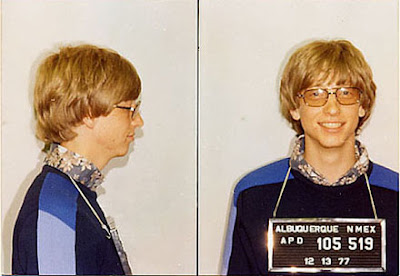 |
| Microsoft Founder Bill Gates: Not the last time he got in trouble with the law |
“The way to be successful in the software world is to come up with breakthrough software, and so, whether it’s Microsoft Office or Windows, it’s pushing that forward: new ideas, surprising the marketplace, so that good businesses and good engineering are the same.”
Bill Gates, Co-founder of Microsoft[i]
A version of Microsoft Windows is used by over 1.5 billion people every day, with about 80% of those using the Microsoft Office package[ii]. Even the arrival of Google Docs, the free-to-use cloud-based version of Microsoft Office hasn’t yet significantly affected the dominance of Microsoft in the software industry. Three of the reasons for Microsoft’s ongoing ubiquity are outlined below:
Microsoft was a pioneer in network effects
Network effects describe the phenomenon that exists whereby increased numbers of participants improve the value of the product or service to new participants.[iii] For many years, Microsoft provided the textbook example of network effects in action: the more users of MS Office that existed, the more likely it was the latest consumer would also purchase it.
One set of authors describes this thus: “Microsoft succeeded in making MS Office the dominant suite of office productivity applications, encouraging users to standardize on MS Office for both business and personal use […] users had little incentive to switch to another word processing software if none of their colleagues were using it.”[iv]
In negotiations with IBM in 1982 to provide its personal computers with operating systems, Paul Allen and Bill Gates purposely decided to forgo per-copy royalty payments on the DOS operating system in order to gain the license for other manufacturers.[v] IBM agreed, allowing DOS to become the standard software package for new computers and providing Microsoft with insurmountable network effects for decades.
Bill Gate has always been a businessman first and a programmer second
From the outset of Microsoft, Bill Gates’ programming wasn’t programming for its own sake (he wasn’t a ‘hobbyist’ as it was known at the time). Finding the right price point for the software – a high enough price to find margin, with a low enough price to scale up quickly – was a key concern for Gates.
As Paul Allen wrote: “Later that year, we made our first sales to third- party manufacturers: Data Technology Corporation, National Cash Register, Citibank, General Electric. All were for flat fees, which locked us in as the exclusive provider of BASIC for their machines. Our strategy was to price our products so low that it wouldn’t pay for hardware companies to develop their own BASIC.”[vi]
Likewise, Gates saw the entry of every new hardware company on the market as a new opportunity to sell Microsoft software. As the United States vs. Microsoft Corp lawsuit[vii] showed, Gates was also not averse to using methods such as bundling to keep Microsoft ahead of the competition. This ongoing commitment to driving sales and market share is what made Microsoft the behemoth it became as much as the programming, for which it is arguably more well-known.
Microsoft maintained a strict focus on software
In 1979, Microsoft had an agent in Japan, who saw the synergies that existed between what was emerging as the world’s most popular software firm (Microsoft) with some Asian tech manufacturers. The agent, Kay Nishi, wanted to introduce Sony to Microsoft. Paul Allen saw the potential, saying that it could be “a true multimedia machine with state-of-the-art audio and video, the sort of thing I’d been talking about for years.”[viii]
Major shareholder Bill Gates refused the offer, however. He was adamant that Microsoft would stay out of hardware for one simple reason: “we’d be in conflict with our customers.” He told the agent that, with over 50 companies licensing Microsoft software at that time, he had the potential to turn them into competitors. Broadly speaking, Microsoft stayed out of hardware for another 30 years.
[i] See: https://www.theguardian.com/lifeandstyle/2016/jun/11/brands-count-cost-celebrity-links-johnny-depp-maria-sharapova-
[ii] https://www.onmsft.com/news/microsoft-numbers-look-how-many-people-are-using-microsofts-products-and-services
[iii] For further reading, see: https://www.investopedia.com/terms/n/network-effect.asp
[iv] Tucker, C. (2018). “Network Effects and Market Power: What have we learned in the last decade?” Antitrust, Spring 2018, pp.72-79.
[v] Allen, P. (2016). “Idea Man: A Memoir by the Cofounder of Microsoft.” Penguin Publishing.
[vi] Allen (2011) p. 111
[vii] https://en.wikipedia.org/wiki/United_States_v._Microsoft_Corp.
[viii] Allen, P. (2016). “Idea Man: A Memoir by the Cofounder of Microsoft.” Penguin Publishing.
No comments:
Post a Comment